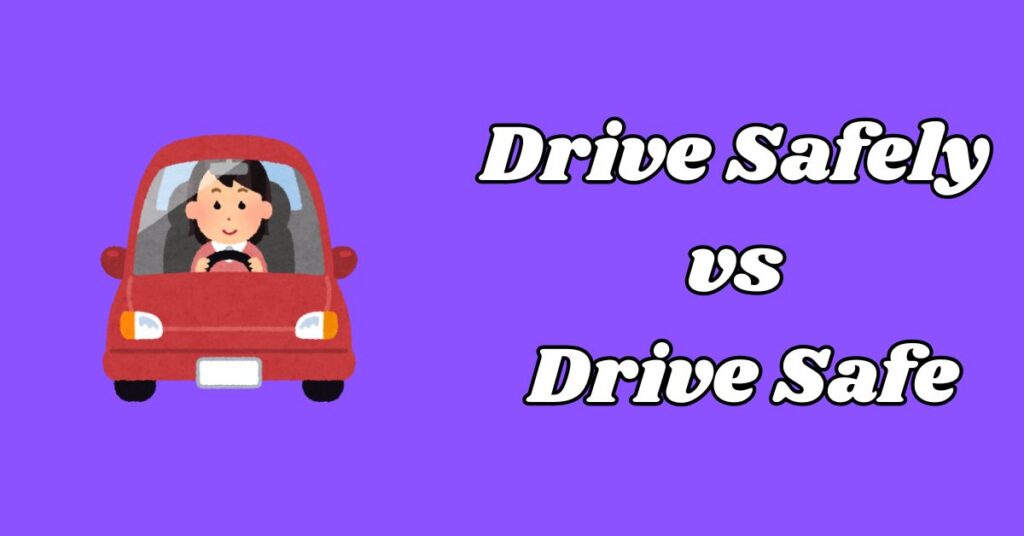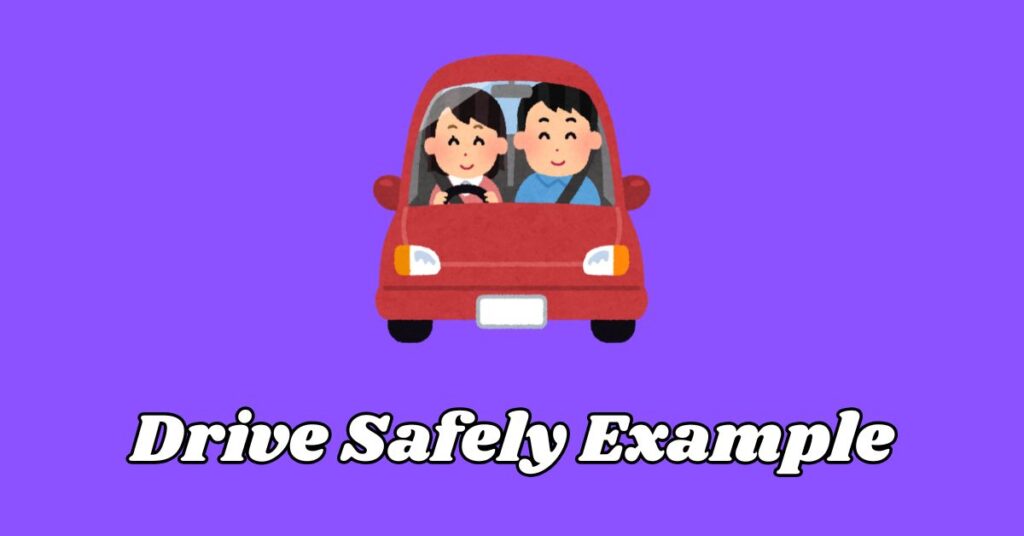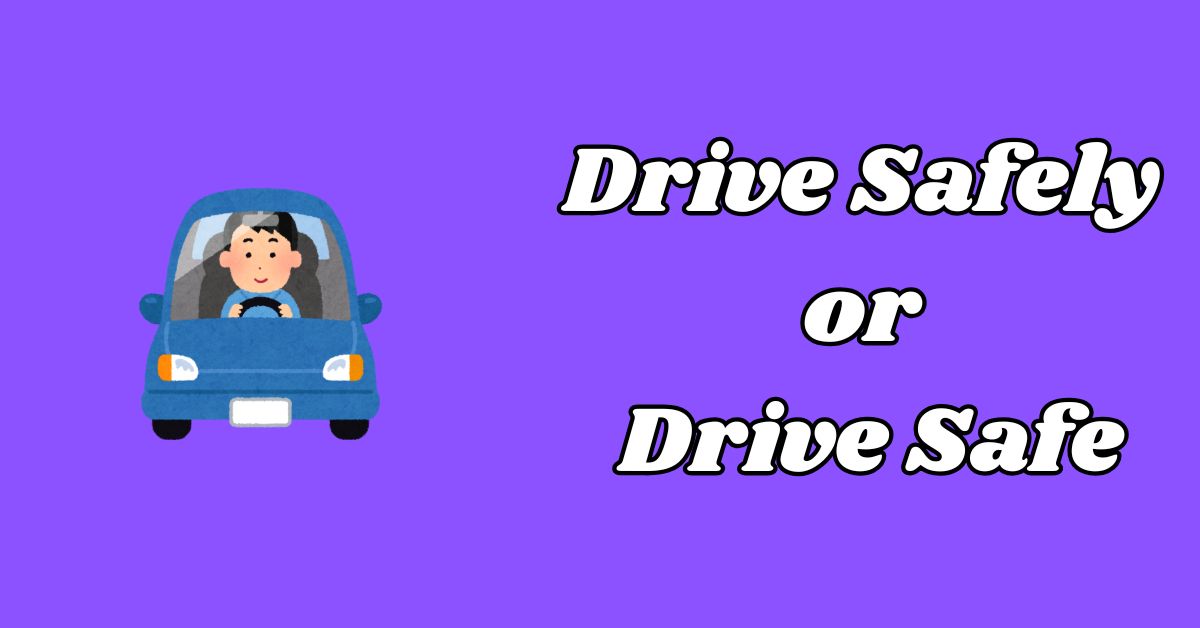Drive Safely or Drive Safe: When it comes to wishing someone a safe journey, these two phrases are often used interchangeably, but they have distinct meanings and uses. The choice between Drive Safely and Drive Safe depends on the context and formality of the situation.
Drive Safely is considered grammatically correct and is used in formal writing or speech to advise on the manner of driving. In contrast, Drive Safe is more informal and commonly used in casual conversations as a parting farewell. Understanding the difference between these phrases can enhance your communication skills in both writing and speech.
Quick Summary
The main difference between “Drive Safely” and “Drive Safe” lies in their grammatical correctness and usage context. “Drive Safely” is considered grammatically correct because it uses the adverbial form “safely,” which modifies the verb “drive.”
On the other hand, “Drive Safe” is more of an informal expression often used in casual speech. This informal usage is common in parting farewells or casual conversations.
Difference Between Drive Safely vs Drive Safe

The debate over “Drive Safely” vs “Drive Safe” often centers around grammar rules and context. “Drive Safely” is typically used in more formal contexts, such as writing or polite conversations, where it serves as a polite way of advising someone on how to drive.
In contrast, “Drive Safe” is more commonly used in casual speech, where it functions as a flat adverb or an adjective to wish someone safety.
Origins of the Word Drive Safely
The phrase “drive safely” combines the action of operating a vehicle with the goal of minimizing risk. It’s a common farewell that conveys concern for someone’s safety. While “drive safely” is grammatically correct, the informal “drive safe” is also used, both conveying a similar meaning.
This distinction highlights the flexibility of language in expressing safety wishes, whether formally or informally.
Drive Safely: Definition and Usage

“Drive Safely” is a phrase that advises on the manner of driving, emphasizing safety. It combines the verb “drive” with the adverb “safely,” derived from “safe,” to convey a risk-free journey.
This phrase is commonly used in formal contexts, such as writing or polite conversations, to express concern for someone’s well-being while driving. It is a grammatically correct way to wish safety, especially in situations requiring caution.
Drive Safely Definition
The phrase “drive safely” is a grammatically correct expression used to advise someone to operate a vehicle in a manner that minimizes risk. It combines the verb “drive” with the adverb “safely,” which modifies the action to emphasize safety.
Commonly used in formal contexts, such as polite farewells or written communication, it conveys concern for the driver’s well-being. For example, saying “Please drive safely” expresses both care and encouragement for responsible driving.
Drive Safely Pronunciation
The pronunciation of “drive safely” includes two syllables: “DRYV SAYF-lee.” The “-ly” suffix adds a slight elongation to the word “safely,” making it distinct from the informal alternative “drive safe.”
To master its pronunciation, break it into sounds “dryv sayf” + “lee” and practice saying it out loud. This phrase is often spoken clearly in formal settings, ensuring the message of safety is effectively communicated.
Drive Safely Usage
“Drive Safely” is commonly used in formal contexts, such as emails, postcards, or academic papers. It serves as a polite way to advise someone to drive carefully, especially in challenging conditions.
For instance, saying “Please drive safely; it’s raining” conveys both concern and caution. This phrase is preferred in situations where clear guidance on safe driving practices is needed.
Used in Conversation
In conversation, “Drive Safely” is often used in more formal or polite exchanges, while “Drive Safe” is common in casual farewells. For instance, saying “Please drive safely” in a formal setting emphasizes caution, whereas “Have a good trip; drive safe” is more informal.
Used in Writing
In writing, “Drive Safely” is preferred for its grammatical correctness, appearing in formal emails or documents. “Drive Safe” is less common in written communication but may be used in informal notes or texts to convey a similar message.
Synonyms of Drive Safely
- Drive Carefully
- Drive Defensively
- Drive with Caution
- Drive Responsibly
- Drive Attentively
- Drive Vigilantly
- Drive Prudently
- Drive Mindfully
- Drive with Awareness
- Drive with Prudence
Drive Safe: Definition and Usage

“Drive Safe” is an informal expression used to wish someone safety while driving. It uses the adjective “safe” to convey a desire for safety without specifying how to drive. This phrase is often used in casual conversations or as a parting farewell.
Despite being less formal, “Drive Safe” effectively communicates a wish for safety and is commonly heard in everyday speech. It is a more relaxed alternative to “Drive Safely,” yet conveys a similar concern for safety.
Drive Safe Definition
“Drive Safe” is an informal expression used to wish someone safety while driving. Unlike the grammatically correct “Drive Safely,” it uses the adjective “safe” instead of the adverbial form.
This phrase is often heard in casual conversations or parting farewells, where strict grammar rules are relaxed. While “Drive Safe” lacks formal grammatical structure, its meaning remains clear: a wish for a secure and risk-free journey, making it widely accepted in everyday speech.
Drive Safe Usage
“Drive Safe” is predominantly used in casual conversations or as a parting farewell. It functions as a concise way to express a wish for safety without detailing how to drive.
For example, saying “Have a good trip; drive safe” is a common way to bid farewell while conveying concern for someone’s safety. This informal expression is widely used in everyday speech.
Uses of Drive Safe in a Sentence
Here are a few examples of how “Drive Safe” might be used in a sentence:
- “Have a good trip; drive safe.”
- “Be careful on the road; drive safe.”
- “It’s getting dark; drive safe.”
- “The roads are slippery; drive safe.”
- “Take care; drive safe.”
Side-by-Side Comparison
| Aspect | Drive Safely | Drive Safe |
| Grammar | Uses the adverb “safely” to modify the verb “drive.” | Uses the adjective “safe” in an informal context. |
| Usage | Formal writing, polite conversations. | Casual speech, parting farewells. |
| Pronunciation | Slight elongation due to the “-ly” suffix. | No elongation. |
| Context | Advises on the manner of driving. | Wishes safety without specifying how to drive. |
Everyday Usage Examples
In everyday life, “Drive Safely” and “Drive Safe” are used differently. “Drive Safely” is often used in formal situations, such as when advising a colleague to be cautious on the road. In contrast, “Drive Safe” is commonly used in casual conversations, like when saying goodbye to a friend who is about to drive.
Both phrases effectively convey a wish for safety, but their usage depends on the context and formality of the interaction.
Drive Safely Example

An example of using “Drive Safely” could be in a message to a family member before a long trip. You might say, “I hope you have a great time at the conference. Please drive safely and take your time on the road.”
This phrase emphasizes the importance of caution and responsible driving, especially when traveling through unfamiliar areas or adverse weather conditions. It shows care for their well-being while reinforcing safe driving practices.
Examples of Drive Safely in Context
Here are few examples:
- “Please drive safely; the roads are slippery.”
- “Remember to drive safely during rush hour.”
- “It’s raining, so drive safely.”
- “The roads are dark and winding; drive safely.”
- “Always drive safely to avoid accidents.”
Drive Safe Example
A typical use of “Drive Safe” might occur when friends part ways after a gathering. For instance, one friend could say, “It was great seeing you tonight! Drive safe on your way home!” This informal expression conveys a friendly wish for safety without being overly formal.
It’s a quick and easy way to show concern for someone’s well-being while keeping the conversation light and casual, making it suitable for everyday interactions.
Examples of Drive Safe in Context
Here are five examples:
- “Have a good trip; drive safe.”
- “Be careful on the road; drive safe.”
- “It’s getting dark; drive safe.”
- “The roads are slippery; drive safe.”
- “Take care; drive safe.”
Common Mistakes
A common mistake is using “Drive Safe” in formal contexts where “Drive Safely” is more appropriate. Conversely, using “Drive Safely” in casual conversations can sound overly formal.
Another error is assuming both phrases are interchangeable without considering the context or audience. Understanding these differences helps avoid confusion and ensures effective communication, whether in writing or speech.
Tips to Avoid the Mistakes
- Understand the Context: Use “Drive Safely” in formal situations and “Drive Safe” in casual ones.
- Know Your Audience: Tailor your choice based on who you’re communicating with.
- Be Aware of Grammar Rules: Recognize that “Drive Safely” is grammatically correct for advising on driving manner.
- Practice Active Listening: Pay attention to how others use these phrases in different contexts.
- Read Widely: Expose yourself to various forms of writing to see how these phrases are used.
Tips to Remember the Differences
- Focus on Formality: “Drive Safely” is more formal.
- Consider the Message: If advising on driving manner, use “Drive Safely.”
- Use in Context: “Drive Safe” is better for casual farewells.
- Listen to Native Speakers: Pay attention to how native speakers use these phrases.
- Practice Regularly: Use both phrases in different scenarios to become more comfortable with their usage.
More Article: Biscuit vs Biscut: Which is the Correct Spelling?
FAQS
Is it Drive Safely or Drive Safe?
Use “Drive Safely” for formal contexts and “Drive Safe” for casual conversations.
Is Drive Safe grammatically correct?
“Drive Safe” is not grammatically correct but is commonly used informally.
What is the meaning of Drive Safely?
“Drive Safely” means to operate a vehicle in a manner that minimizes risk and ensures safety.
Conclusion
Understanding the difference between “Drive Safely” and “Drive Safe” enhances your communication skills. “Drive Safely” is the more formal and grammatically correct choice, ideal for advising on safe driving practices.
Meanwhile, “Drive Safe” is an informal expression suitable for casual conversations. By choosing the right phrase, you can effectively convey concern for safety in various contexts. Whether you say “Drive Safely” or “Drive Safe,” both phrases convey a wish for a safe journey, making them valuable in everyday interactions.
Related Post: Mantel vs Mantle: What’s the Difference?

